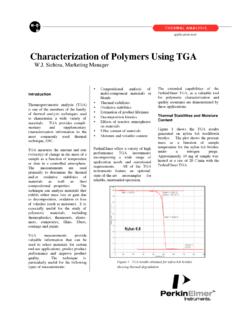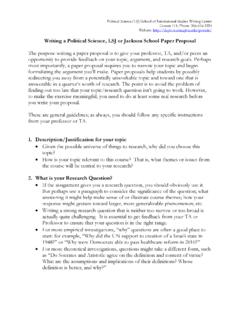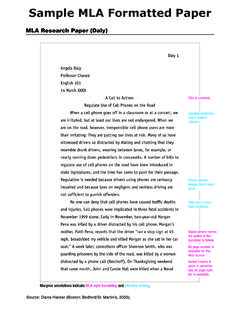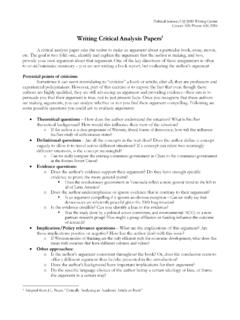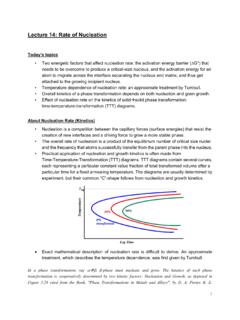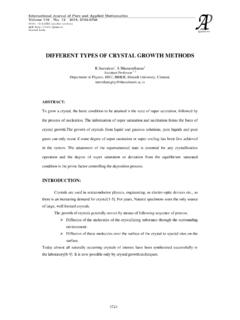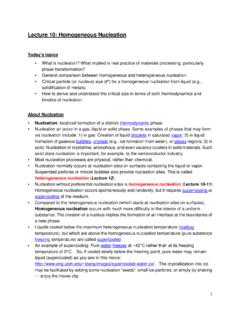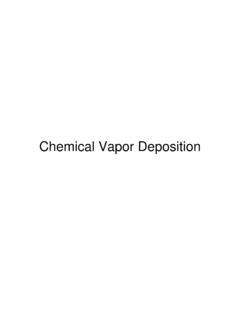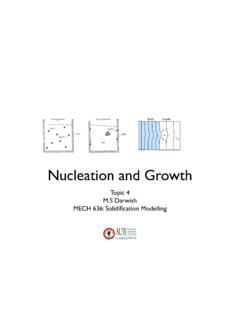Transcription of 3.2.1. Fundamentals of Homogeneous Nucleation Figure 3
1 Fundamentals of Homogeneous Nucleation When the concentration of a solute in a solvent exceeds its equilibrium solubility or temperature decreases below the phase transformation point, a new phase appears. Let us consider the case Homogeneous Nucleation of a solid phase from a supersaturated solution as an example. A solution with solute exceeding the solubility or supersaturated possesses a high Gibbs free energy; the overall energy of the system would be reduced by segregating solute from the solution. Figure is a schematic showing the reduction of the overall Gibbs free energy of a supersaturated solution by forming a solid phase and maintaining an equilibrium concentration in the solution.
2 This reduction of Gibbs free energy is the driving force for both Nucleation and growth . The change of Gibbs free energy per unit volume of the solid phase, Gv, is dependent on the concentration of the solute: Gv = - kT/ ln(C/Co) = - kT/ ln(1+ ) ( ) where C is the concentration of the solute, Co is the equilibrium concentration or solubility, is the atomic volume, and is the supersaturation defined by (C-Co)/Co. Without supersaturation ( , = 0), Gv is zero, and no Nucleation would occur. When C > Co, Gv is negative and Nucleation occurs spontaneously. Assuming a spherical nucleus with a radius of r is formed, the change of Gibbs free energy or volume energy, v, can be described by: v = (4/3) r3 Gv ( ) However, this energy reduction is counter balanced by the introduction of surface energy, which accompanied with the formation of new phase.
3 This results in an increase in the surface energy, s, of the system: s = 4 r2 ( ) where is the surface energy per unit area. The total change of chemical potential for the formation of the nucleus, G, is given by: G = v + s = (4/3) r3 Gv + 4 r2 ( ) Figure schematically shows the change of volume free energy, v, surface free energy, s, and total free energy, G, as functions of nucleus radius. From this Figure , one can easily see that the newly formed nucleus is stable only when its radius exceeds a critical size, r*. A nucleus smaller than r* will dissolve into the solution to reduce the overall free energy, whereas a nucleus larger than r* is stable and continues to grow bigger.
4 At the critical size r = r*, d G/dr = 0 and the critical size, r*, and critical energy, G*, are defined by: r* = -2 / Gv ( ) G* = 16 /3( Gv)2 ( ) 1 G* is the energy barrier that a Nucleation process must overcome and r* represents the minimum size of a stable spherical nucleus. The above discussion was based on a supersaturated solution; however, all the concepts can be generalized for a supersaturated vapor and a supercooled vapor or liquid. In the synthesis and preparation of nanoparticles or quantum dots by Nucleation from supersaturation solution or vapor, this critical size represents the limit how small nanoparticles can be synthesized.
5 To reduce the critical size and free energy, one need to increase the change of Gibbs free energy, Gv, and reduce the surface energy of the new phase, . Equation indicate that Gv can be significantly increased by increasing the supersaturation, , for a given system. Figure compares the critical sizes and critical free energy of three spherical nuclei with different values of supersaturation, which increases with a decreasing temperature. Temperature can also influence surface energy. Surface energy of the solid nucleus can change more significantly near the roughening temperature. Other possibilities include: (1) use of different solvent, (2) additives in solution, and (3) incorporation of impurities into solid phase, when other requirements are not compromised.
6 The rate of Nucleation per unit volume and per unit time, RN, is proportional to (1) the probability, P, that a thermodynamic fluctuation of critical free energy, G*, given by: P = exp (- G*/kT) ( ) (2) the number of growth species per unit volume, n, which can be used as Nucleation centers (in Homogeneous Nucleation , it equals to the initial concentration, Co), and (3) the successful jump frequency of growth species, , from one site to another, which is given by: = kT/(3 3 ) ( ) where is the diameter of the growth species and is the viscosity of the solution. So the rate of Nucleation can be described by: RN = n P = {Co k T/(3 3 )}exp(- G*/kT) ( ) This equation indicates that high initial concentration or supersaturation (so a large number of Nucleation sites), low viscosity, and low critical energy barrier are favoring the formation of a large number of nuclei.
7 For a given concentration of solute, a larger number of nuclei mean smaller sized nuclei. Figure schematically illustrated the processes of Nucleation and subsequent growth . When the concentration of solute increases as a function of time, no Nucleation would occur even above the equilibrium solubility. The Nucleation occurs only when the supersaturation reaches a certain value above the solubility, which corresponds to the energy barrier defined by equation for the formation of nuclei. After the initial Nucleation , the concentration or supersaturation of the growth species decreases and the change of volume Gibbs free energy reduces.
8 When the concentration decreases below this certain concentration, which 2corresponds to the critical energy, no more nuclei would form, whereas the growth will proceed until the concentration of growth species reached the equilibrium concentration or solubility. Figure schematically shows, from a slightly different point of view, the relations between the Nucleation and growth rates and the concentration of growth species1. When the concentration of the growth species increases above the equilibrium concentration, initially there will be no Nucleation . However, Nucleation occurs when the concentration reaches the minimum saturation required to generate the critical free energy, and the Nucleation rate increases very rapidly as the concentration increases further.
9 Although growth process cannot proceed when there is no nucleus, growth rate is above zero for a concentration above its equilibrium solubility. Once nuclei are formed, growth occurs simultaneously. Above the minimum concentration, Nucleation and growth are inseparable processes; however, these two processes proceed in different speeds. For the synthesis of nanoparticles with uniform size distribution, it will be the best if all nuclei form at the same time with the same size. In this case, all the nuclei are likely to have the same or similar size, since they are formed under the same conditions. In addition, all the nuclei will have the same subsequent growth .
10 Consequently, monosized nanoparticles can be obtained. So it is obvious that it is highly desirable to have Nucleation occur in a very short period of time. In practice, to achieve a sharp Nucleation , the concentration of the growth species is increased abruptly to a very high supersaturation and then is quickly brought below the minimum concentration for Nucleation . Below this concentration, no more new nucleus forms, whereas the existing nuclei continue to grow until the concentration of the growth species reduces to the equilibrium concentration. The size distribution of nanoparticles can be further altered in the subsequent growth process.
